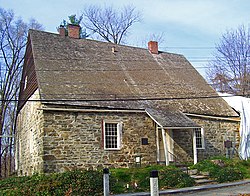Jean Hasbrouck House
Jean Hasbrouck House | |
 | |
  | |
| Location | Huguenot Street, New Paltz, New York |
|---|---|
| Nearest city | Poughkeepsie |
| Coordinates | 41°45′03.1″N 74°05′17.8″W / 41.750861°N 74.088278°WCoordinates: 41°45′03.1″N 74°05′17.8″W / 41.750861°N 74.088278°W |
| Area | less than one acre |
| Built | 1694; 1712 |
| Architectural style | Stone house |
| Part of | Huguenot Street Historic District (ID66000578) |
| NRHP reference No. | 67000016 |
| Significant dates | |
| Added to NRHP | December 24, 1967[1] |
| Designated NHL | December 24, 1967[2] |
| Designated NHLDCP | October 9, 1960 |
The Jean Hasbrouck House is a historic house on Historic Huguenot Street in New Paltz, New York. Built in 1721, it is one of the best examples of colonial Dutch architecture in stone in the United States.[3] The house is a National Historic Landmark and is part of the larger Huguenot Street Historic District, also a National Historic Landmark.
History of the house[]
The house was built in 1721 by Jean Hasbrouck's son Jacob, and perhaps incorporates elements of a timber-framed home built by Jean Hasbrouck on the same site circa 1678. The Hasbroucks were Huguenots who fled persecution in France and co-founded New Paltz. Their house is considered an excellent example of Hudson Valley Dutch architecture and is well preserved. It received its current designation in 1967.
Significant features include a wide center hallway, a substantial attic space, originally used as a garret, and the only original 18th century jambless fireplace found in the houses of Historic Huguenot Street. The north wall underwent a substantial restoration in 2006, which included the installation of reproduction Dutch-style casement windows.[4]
The house served as both a home for family members and a store for the small village. Several enslaved individuals owned by the Hasbroucks also lived on the site, three of whom were named in Jean Hasbrouck's will as "Gerritt," "James," and "Molly."[5] Several generations of Hasbrouck family members lived in the house, including Josiah Hasbrouck, who served in U.S. Congress during the Thomas Jefferson and James Madison administrations, and who built the substantial Locust Lawn Estate just outside New Paltz.
The house was purchased by the organization known today as Historic Huguenot Street in 1899, and has been used as a museum ever since. Guided tours are available to the public by appointment.
[2][3]
References[]
- ^ "National Register Information System". National Register of Historic Places. National Park Service. January 23, 2007.
- ^ a b "Jean Hasbrouck House". National Historic Landmark summary listing. National Park Service. 2007-09-15. Archived from the original on 2011-06-05.
- ^ a b James Dillon (January 1975). "National Register of Historic Places Inventory-Nomination: The Jean Hasbrouck House" (pdf). National Park Service.
{{cite journal}}: Cite journal requires|journal=(help) and Accompanying photos, 3 exterior and 1 interior, from 1967 and 1974. (1.94 MB) - ^ Huguenot Historical Society, Jean (Jacob) Hasbrouck House Restoration Campaign 2006 Archived 2007-09-27 at the Wayback Machine, retrieved June 3, 2007.
- ^ 1712 Jean Hasbrouck Will document
External links[]
| Wikimedia Commons has media related to Jean Hasbrouck House. |
- Jean Hasbrouck House at Historic Hasbrouck Houses on the Hasbrouck Family Association website.
- Historic American Buildings Survey (HABS) No. NY-471, "Jean Hasbrouck House, Hugenot Street, New Paltz, Ulster County, NY", 20 photos, 16 measured drawings, 2 data pages, 2 photo caption pages
- Restoration Plastering Work
- Huguenot history in the United States
- National Historic Landmarks in New York (state)
- Houses in Ulster County, New York
- National Register of Historic Places in Ulster County, New York
- New Paltz, New York
- Houses completed in 1721
- Museums in Ulster County, New York
- Historic house museums in New York (state)
- Biographical museums in New York (state)
- Historic American Buildings Survey in New York (state)
- Historic district contributing properties in New York (state)
- Stone houses in New York (state)
- 1721 establishments in New York